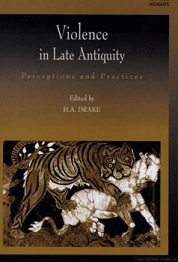Book Review: Violence in Late Antiquity. Perceptions and Practices

Bryn Mawr Classics (Reviewed by Paul Stephenson, University of Durham)
This book has three papers related to Egypt:
- Embodied Theologies: Popular Mobilization and Violence in Alexandria in the Early Arian Controversy by Carlos Galvao-Sobrinho
- The Murder of Hypatia: Acceptable or Unacceptable Violence? by Edward Watts
In his clever introduction H. A. Drake offers an extended meditation on an image of violence, part of the opus sectile pavement in the basilica of Junius Bassus, which portrays a tiger munching on the neck of a rather shocked calf. This, we are encouraged to believe, provoked the editor to divide the essays into four categories: 'real' violence, committed by 'barbarians' and others; 'legitimate' violence, committed by those who claimed a state monopoly; rhetorical violence; and religious violence. If we were credulous, this would explain the odd placement of some of the papers (for example, Sizgorich's would surely better be read alongside McDonough's, Clark's would complement that by Torallas Tovar).
But the proffered framework is evidently a conceit, which creaks ('it is, therefore, not unimportant that the tigress-calf mosaic comes from a type of setting [where] ... men like Junius Bassus heard cases ... associated with the administration of Roman law') and groans ('Radical rethinking such as that exhibited in the fifth-century Church historians ... calls us back once again to Junius Bassus's mosaic. The structure that it was housed in was adapted by Christians a century later ...') as it changes gears. This is a shame, as the ubiquity of the image that Drake discusses does invite further reflection, not only on the consonant ubiquity of violence in late antiquity.
- Nato Raids Spared Libyan Antiquities
The Associated Press Libya's famed ancient Roman sites, including the sprawling seaside ruins of Leptis Magna, were spared damage by NATO during the recent airstrikes, says a London-based Libyan archaeologist . Hafed Walda, a research fellow at Kings...
- Online: Greek, Roman And Byzantine Studies
Duke University A vast list of texts available online at Duke, including Roger S. Bagnall's The Florida Ostraka: Documents from the Roman Army in Upper Egypt (1976) and Ari Z. Bryen's Visibility and Violence in Petitions from Roman Egypt (2008)....
- Book Review: Riot In Alexandria
Bryn Mawr Classical Review (Reviewed by Peter Van Nuffelen) Edward J. Watts, Riot in Alexandria: Tradition and Group Dynamics in Late Antique Pagan and Christian Communities. The Transformation of the Classical Heritage 46. Berkeley/Los Angeles/London:...
- Tourism: Luxor Massacre Changed Tourism In Egypt
Egypt Daily Star It was a stunning attack, still recalled with horror a decade later: Terrorists armed with knives and automatic weapons massacred 58 foreign tourists, mainly Germans, Swiss and Japanese, at one of Egypt's most popular pharaonic temples.But...
- Malawi Museum Damaged And Looted
Things are looking worse for Egypt with riots and violence taking hold including the burning of Coptic churches and the damaging and looting of the Malawi museum supposedly of most of its artifacts. Yesterday it was announced that all museums and archaeological...
